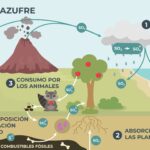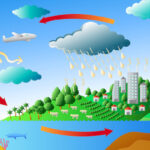We explain what the carbon cycle is and what the stages of this biogeochemical cycle consist of. Also, why it is important for life.

What is the carbon cycle?
The carbon cycle is the process of carbon circulation on planet Earth. Through this cycle, Carbon is transported between different ecosystems and the environment that surrounds them. Thus, carbon is transferred between the biosphere, the lithosphere, the hydrosphere and the atmosphere.
The carbon cycle is a global cycle, but even so, during this cycle the chemical compounds that contain carbon will be different depending on each region. Thus, carbon forms different chemical compounds present in different parts of the biosphere and its environment. For example: carbon mineral reserves underground, inorganic carbon dissolved in seawater, and carbon dioxide (CO2) in the atmosphere.
See also: Carbon
Characteristics of the carbon cycle
Some aspects that characterize the carbon cycle are:
- It's a global cycle. Carbon is widely distributed in the atmosphere of the entire planet.
- It is made up of two general stages. It is made up of a slow stage and a fast stage. The fast stage is linked to the biological processes experienced by living beings, which are faster than geological processes, such as the formation of fossil fuels, which correspond to the slow stage.
- During the cycle, different chemical compounds are formed. Through the different stages, carbon forms chemical compounds in different states of aggregation (solid, liquid, gaseous).
See also: Biogeochemical cycles
Stages of the carbon cycle
The carbon cycle is made up of several stages and processes that this chemical element goes through to transport itself between living beings, and between living beings and the environment that surrounds them.
The stages of the carbon cycle are:
Rapid or biological stage
In the rapid stage, the biological processes of living organisms intervene. It is made up of the following processes:
- Carbon fixation by plants. When plants and some bacteria carry out the process of photosynthesis, they fix carbon by using sunlight and carbon dioxide (CO2) of the atmosphere.
- Release of carbon into the atmosphere. CO is released2 to the atmosphere due to cellular respiration in living organisms, the respiration of plants during the night and the decomposition of organic matter after the death of living beings.
Slow or geological stage
In the slow stage, chemical and physical processes intervene that contribute to the exchange of carbon in the different layers of the Earth. It is made up of the following processes:
- Carbon mineralization and sedimentation. Carbon accumulates and settles, so it can form fossils and fossil fuels.
- Carbon release due to metamorphism. When rocks containing carbon move, carbon can be released. In addition, carbon is also released during the eruption of volcanoes.
- CO release2 and methane (CH4) in human activities. During mining activity and in many industrial processes, large amounts of carbon are released (in the form of CO2 and C.H.4) to the atmosphere.
Importance of the carbon cycle
The carbon cycle is extremely important for maintaining life as we know it. Through this cycle, carbon is transported from one place to another on the planet and forms part of different chemical compounds that have different uses, both for living beings and for geological and industrial processes.
It is a very important cycle because Carbon is part of the essential molecules that make up living beings such as proteins, DNA, RNA, carbohydrates and lipids. Furthermore, carbon is a fundamental element during the photosynthesis process.
On the other hand, carbon is part of many fuels. It is essential for the plastics industry, the pharmaceutical industry and the production of numerous products such as lacquers, paints and cosmetics.
See also: Oxygen cycle
Alterations due to human impact on the carbon cycle
Human beings have intervened in the amount of carbon that circulates on the planet. Carbon dioxide and methane emissions (due to the burning of fossil fuels and industrial activity) have caused the increase of carbon in the atmosphere.
Additionally, wildfires also increase carbon levels in the atmosphere. The increase in carbon dioxide in the atmosphere is one of the main reasons for the increase in the greenhouse effect
When solar radiation hits the Earth, a part reaches the atmosphere and is reflected back into space, while the other part reaches the ground, which causes it to heat up.
The greenhouse effect is the process by which the part of the solar radiation that hits the Earth and that should leave is absorbed by a set of atmospheric gases that cause this radiation to be emitted in many directions. This process generates an increase in the temperature of the Earth's surface, and this set of atmospheric gases is called greenhouse gases.
The main greenhouse gases are carbon dioxide (CO2), methane (CH4), water vapor (H2O), nitrous oxide (N2O) and ozone (O3). Alterations in the cycles of any of these chemical elements can contribute to an increase in the greenhouse effect, overheating the surface of our planet.
See also:
document.addEventListener(“DOMContentLoaded”, (e) => {
var sliderContainer, slider;
sliderContainer = document.getElementById(‘block_8e0b6736c59d455ef75b1b661ce9de08’);
if (typeof initSlider !== ‘function’) {
console.log(‘Swiper haven\’t been loaded’);
sliderContainer.className += ‘ fw scroll-snap’;
return;
};
options = {
direction: ‘horizontal’,
speed: 1000,
slidesPerView: ‘auto’,
// slidesPerGroup: 1,
centerInsufficientSlides: true,
// centeredSlides:true,
spaceBetween: 15,
breakpoints: {
720: {
// centeredSlides: false,
// slidesPerGroup: 2,
spaceBetween: 25
},
},
pagination: {
el: ‘.swiper-pagination’,
type: ‘bullets’,
clickable: true
},
}
slider = initSlider(sliderContainer, options);
})
References
- Gallardo, JF, & Merino, A. (2007). The carbon cycle and the dynamics of forest systems.
- Jaramillo, VJ (2004). The global carbon cycle. Climate change: a view from Mexico, 77(1), 77-85.
- Martínez, E., Fuentes, JP, & Acevedo, E. (2008). Organic carbon and soil properties. Journal of Soil Science and Plant Nutrition, 8(1), 68-96.
- ROJAS GARCIA, FABIOLA, Santoyo Gómez, GH, GONZALEZ MONTIEL, ELIZABETH, VELAZQUEZ RODRIGUEZ, AS, & PULIDO PONCE, JI (2017). Soil science in the carbon cycle of Mexico. Institutional repository. Autonomous University of Mexico.





